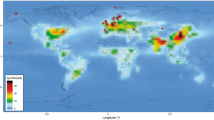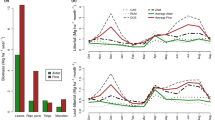Abstract
Hypogymnia physodes was sampled from 179 sites of Scots pine forests regularly distributed throughout Norway. The purpose was to map the nitrogen and sulphur contents of lichen thalli on a large-scale geographical basis, and to relate these values to differences in atmospheric deposition and climate.
The lichen nitrogen and sulphur concentrations showed large differences; the highest concentration values being 4–5 times greater than the lowest. The highest nitrogen and sulphur values occurred along the coast of southern Norway and on some sites in the inland of southern Norway. There was a close correlation between the two elements. The lichen N/S ratio decreased with increasing latitude.
The nitrogen and sulphur contents ofHypogymnia physodes were both significantly correlated to estimated atmospheric deposition of these two elements in Norway. The degree of explanation improved when climatic variables such as temperature sum, altitude, annual precipitation and temperature were included. Factors promoting growth, such as high bark pH, mild winters, hot summers, high precipitation, high ammonium deposition and high evapotranspiration, were all associated with lower lichen nitrogen and/or sulphur concentrations. Unfavourable growth conditions, such as at high altitude, was related to higher concentrations than expected from deposition models. This indicates that differences in element concentration between nearby localities might be related to local differences in climate and lichen growth conditions. This should be taken into consideration whenever using lichens for biomonitoring.
Similar content being viewed by others
References
Abacus Concepts: 1988,StatView SE+Graphics, v. 103, BrainPower Inc.
Arndt, U., Nobel, W., and Schweitzer, M.: 1987,Flechten als Bioindikatoren. Möglichkeiten, Grenzen und neue Erkentnisse, Verlag Eugen Ulmer, Stuttgart.
Case, J. W. and Krouse H. R.: 1980, ‘Variations in Sulphur Content and Stable Isotope Composition of Vegetation near a SO2 Source at Fox Creek, Alberta, Canada,Oecologia 44, 248–257.
Chapin III, F. S., Johnson, D. A., and McKendrick, J. D.: 1980, ‘Seasonal Movement of Nutrients in Plants of Differing Growth Form in an Alaskan Tundra Ecosystem: Implications for Herbivory’,Journal of Ecology 68, 189–209.
Cramer, W. and Prentice, I. C.: 1988, ‘Simulation of Soil Moisture Deficits on a European Scale’,Norsk Geogr. Tidsskr. 42, 149–151.
De Bakker, A. J.: 1989, ‘Effects of Ammonia Emission on Epiphyte Lichen Vegetation’,Acta Bot. Neerl. 38, 337–342.
Eliassen, A., Hov, Ø., Iversen, T., Saltbones, J., and Simpson, D.: 1988,Estimates of Transboundary Transport of Sulphur and Nitrogen over Europe, European Monitoring and Evaluation Programme EMEP/MSC-W Report 1/88.
Ferry, B. W., Baddeley, M. S., and Hawksworth, D. L. (Eds.): 1973,Air Pollution and Lichens, The Athlone Press, London.
Folkeson, L.: 1979, ‘Interspecies Calibration of Heavy-Metal Concentration in Nine Mosses and Lichens: Applicability to Deposition Measurements’,Water, Air, and Soil Pollut. 11, 253–260.
Green, T. G. A., Horstmann, J., Bonnett, H., Wilkins, A., and Silvester, W. B.: 1980, ‘Nitrogen Fixation by Members of the Stictaceae (Lichens) of New Zealand,New Phytol. 84, 339–348.
Hawksworth, D. L. and Rose, F.: 1970, ‘Qualitative Scale for Estimating SO2 Air Pollution in England and Wales Using Epiphytic Lichens’,Nature 277, 145–148.
Henderson, A.: 1992, ‘Literature on Air Pollution and Lichens XXXV’,Lichenologist 24, 193–200.
Holopainen, T. and Kärenlampi, L.: 1984, ‘Injuries to Lichen Ultrastructure Caused by Sulphur Dioxide Fumigations’,New Phytol. 98, 285–294.
Holopainen, T. and Kärenlampi, L.: 1985, ‘Characteristic Ultrastructural Symptoms Caused in Lichens by Experimental Exposure to Nitrogen Compounds and Fluorides’,Ann. Bot. Fennici 22, 333–342.
Horntvedt, R.: 1975, ‘Epiphytic Macrolichens on Scots Pine Related to Air Pollution from Industry in Odda, Western Norway’.Rep. Norwegian Forest Res. Inst. 31, 584–604.
Iversen, T., Halvorsen, N. E., Mylona, S., and Sandnes, H.: 1991,Calculated Budgets for Airborne Acidifying Components in Europe, 1985, 1987, 1988, 1989 and 1990, European Monitoring and Evaluation Programme EMEP/MSC-W Report 1/91.
Kärenlampi, L., Oksanen, J., and Anttonen, T.: 1989, ‘Growth Rate of Epiphytic Lichens as a Bioindicator’, in Bucher, J. B. and Bucher-Wallin, I. (Eds.),Air Pollution and Forest Decline, Proc. 14th Int. Meeting for Specialists in Air Pollution Effects on Forest Ecosystems, Switzerland, pp. 445–446.
Kauppi, M.: 1980,The Influence of Nitrogen-Rich Pollution Components on Lichens, Acta Univ. Oul. A101, Biol. 9.
Kauppi, M. and Mikkonen, A.: 1980, ‘Floristic versus Single Species Analysis in the Use of Epiphytic Lichens as Indicators of Air Pollution in a Boreal Forest Region, Northern Finland’,Flora 169, 255–281.
Kershaw, K. A.: 1985,Physiological Ecology of Lichens, Cambridge Studies in Ecology, Cambridge University Press.
Kubin, E.: 1990, ‘A Survey of Element Concentrations in the Epiphytic LichenHypogymnia physodes in Finland in 1985–86’, in Kauppi, P., Antilla, P., and Kenttämies, K. (Eds.),Acidification in Finland, Springer Verlag, Berlin-Heidelberg, pp. 421–446.
Leemans, R. and Cramer, W. P.: 1991,The IIASA Database for Mean Monthly Values of Temperature, Precipitation and Cloudiness on a Global Terrestrial Grid, RR-91-18 International Institute for Applied System Analysis, Laxenburg, Austria.
Lövblad, G., Amann, M., Andersen, B., Hovmand, M., Joffre, S., and Pedersen, U.: 1992, ‘Deposition of Sulfur and Nitrogen in the Nordic Countries: Present and Fugure’,Ambio 21, 339–347.
Markert, B. and Weckert, V.: 1989, ‘Fluctuations of Element Concentrations During the Growing Season ofPolytrichum formosum (Hedw.)’,Water, Air, and Soil Pollut. 43, 177–189.
Marti, J.: 1985,Die Toxizität von Zink-, Schwefel- und Stickstoff-verbindungen auf Flechten-Symbionten, Bibl. Lichenol. 21, J. Cramer, Vaduz.
Nash, III, T. H.: 1973, ‘Sensitivity of Lichens to Sulphur Dioxide’,Bryologist 76, 333–339.
Nash, III, T. H.: 1976, ‘Sensitivity of Lichens to Nitrogen Dioxide Fumigations’,Bryologist 79, 103–106.
Nash, III, T. H. and Wirth, V. (Eds.): 1988,Lichens, Bryophytes and Air Quality, J. Cramer, Berlin-Stuttgart.
O'Hare, G. P.: 1974, ‘Lichens and Bark Acidification as Indicators of Air Pollution in West Central Scotland’,J. Biogeogr. 1, 135–146.
Pakarinen, P.: 1985, ‘Mineral Element Accumulation in Bog Lichens’, in Brown, D. H. (Ed.),Lichen Physiology and Cell Biology, Plenum Press, New York, pp. 185–192.
Pedersen, U., Walker, S. E., and Kibsgaard, A.: 1990,Kart over atmosfœrisk avsetning av svovelog nitrogenforbindelser i Norge (Deposition Mapping of Sulphur and Nitrogen Compounds in Norway), Norwegian Institute for Air Research NILU OR 28/90.
Pike, L. H.: 1978, ‘The Importance of Epiphytic Lichens in Mineral Cycling’,Bryologist 81, 247–257.
Prentice, I. C., Sykes, M. T., and Cramer, W.: 1993, ‘A Simulation Model for the Transient Effects of Climate Change on Forest Landscapes’,Ecological Modelling 65, 51–70.
Pucket, K. J.: 1985, ‘Temporal Variation in Lichen Element Levels’, in Brown, D. H. (Ed.),Lichen Physiology and Cell Biology, Plenum Press, New York, pp. 211–225.
Sokal, R. R. and Rohlf, F. J.: 1981,Biometry, W. H. Freeman & Co., New York.
Steinnes, E.: 1993, ‘Some Aspects of Biomonitoring of Air Pollutants Using Mosses, as Illustrated by the 1976 Norwegian Survey’, in Markert, B. (Ed.),Plants as Biomonitors for Heavy Metal Pollution in the Terrestrial Environment, VCH Verlag (in print).
Steinnes, E., Frantzen, F., Johansen, O., Rambæk, J. P., and Hanssen, J. E.: 1988, ‘Atmosfœrisk nedfall av tungmetaller i Norge. Landsomfattende undersøkelse 1985 (Atmospheric Deposition of Trace Elements in Norway. National Survey 1985), The Norwegian State Pollution Control Authority (Statens forurensningstilsyn), Report 334/88.
Steinnes, E., Rambæk, J. P., and Hanssen, J. E.: 1992, ‘Large Scale Multi-Element Survey of Atmospheric Deposition Using Naturally Growing Moss as Biomonitor’,Chemosphere 25, 735–752.
Takala, K., Olkkonen, H., Ikonen, J., Jääskeläinen, J., and Puumalainen, P.: 1985, ‘Total Sulphur Contents of Epiphytic and Terricolous Lichens in Finland’,Ann. Bot. Fennici 22, 91–100.
Tamm, C. O.: 1991,Nitrogen in Terrestrial Ecosystems, Ecological Studies 81, Springer Verlag, Berlin-Heidelberg.
The Norwegian State Pollution Control Authority (Statens forurensningstilsyn): 1987,Overvåking av langtransportert forurenset luft og nedbør. Årsrapport 1986 (Norwegian Monitoring Programme for Long-Range Transported Air Pollutants, Report 296/87.
Ibid.: 1988,Overvåking av langtransportert forurenset luft og nedbør. Årstrapport 1987, Report 333/88.
Ibid.: 1989,Overvåking av langtransportert forurenset luft og nedbør. Årsrapport 1988, Report 375/89.
Ibid.: 1991a,Overvåking av langtransportert forurenset luft og nedbør. Årsrapport 1989, Report 437/91.
Ibid.: 1991b,Overvåking av langtransportert forurenset luft og nedbør. Årsrapport 1990, Report 466/91.
Von Arb, C.: 1987, ‘Photosynthesis and Chlorophyll Content of the LichenParmelia sulcata Taylor from Locations with Different Levels of Air Pollution’, in Peveling, E. (Ed.),Progress and Problems in Lichenology in the Eighties, Bibl. Lichenol. 25, J. Cramer, Vaduz, pp. 343–345.
Westman, L.: 1975, ‘Air Pollution and Vegetation Around a Sulphite Mill at Örnsköldsvik, North Sweden’,Wahlenbergia 2, 1–146.
Author information
Authors and Affiliations
Rights and permissions
About this article
Cite this article
Bruteig, I.E. The epiphytic lichen hypogymnia physodes as a biomonitor of atmospheric nitrogen and sulphur deposition in Norway. Environ Monit Assess 26, 27–47 (1993). https://doi.org/10.1007/BF00555060
Received:
Issue Date:
DOI: https://doi.org/10.1007/BF00555060




